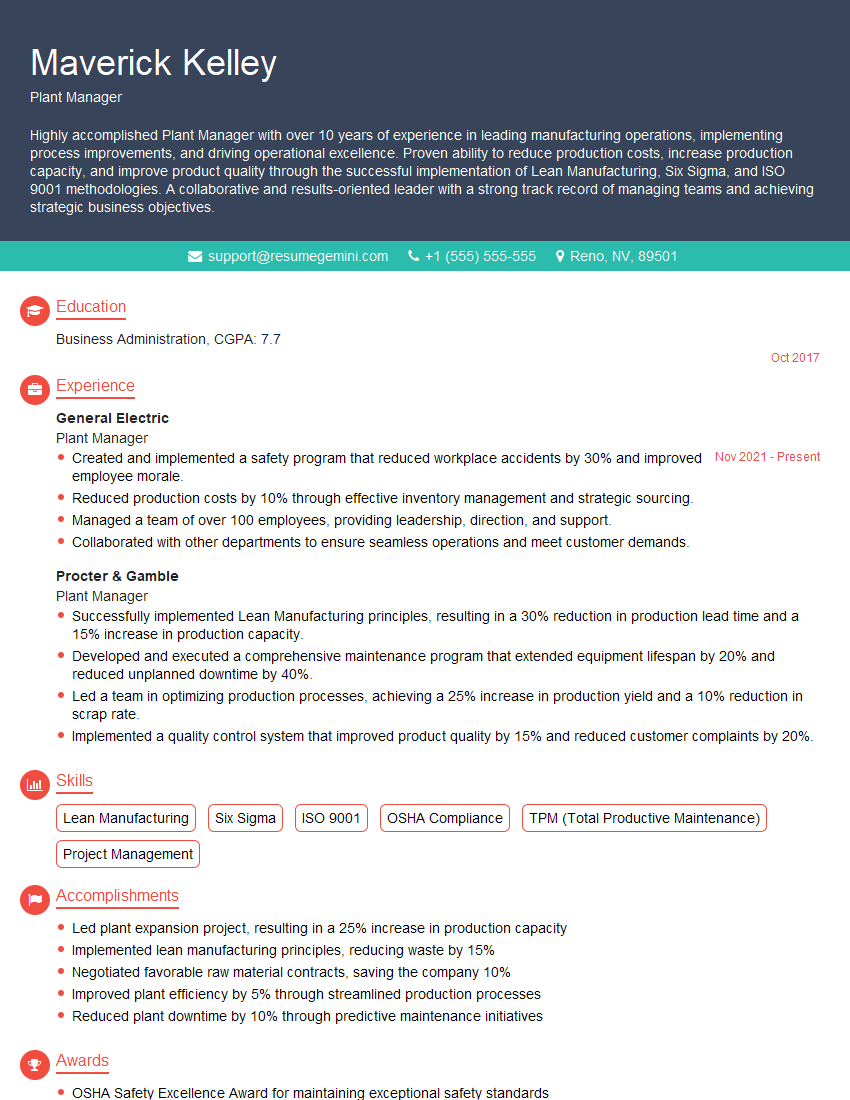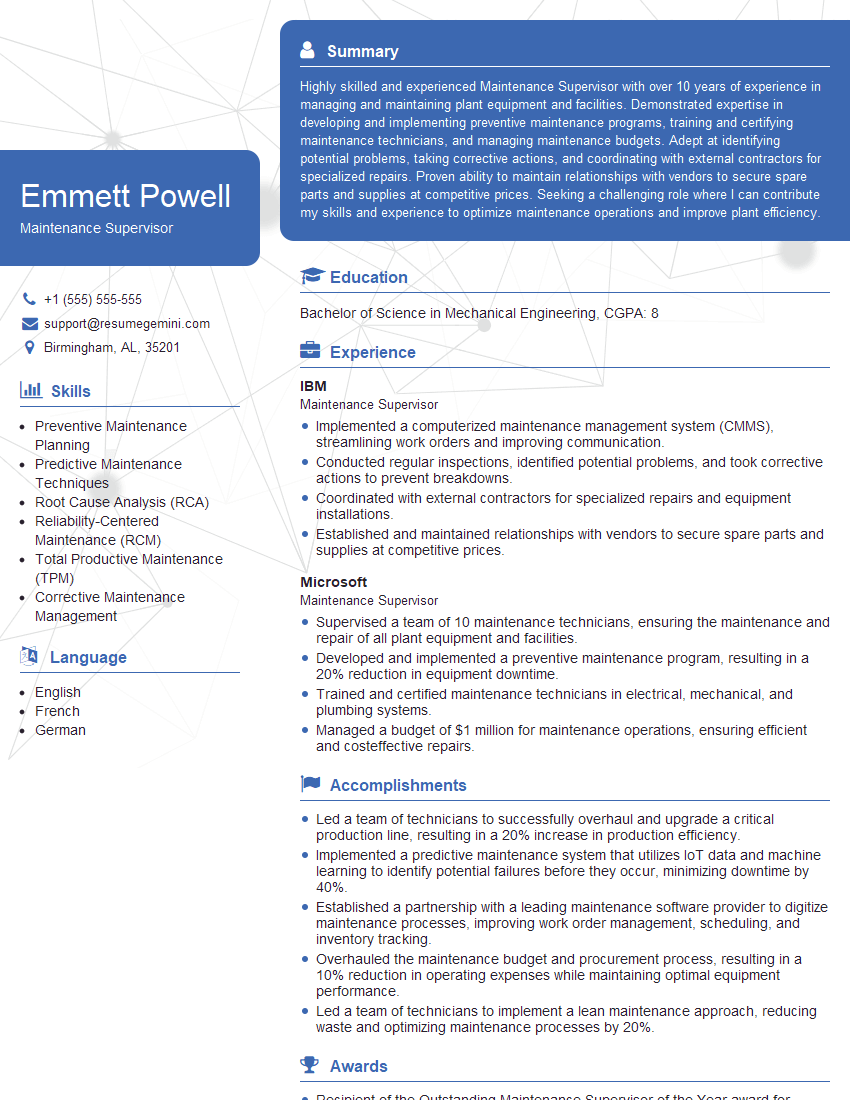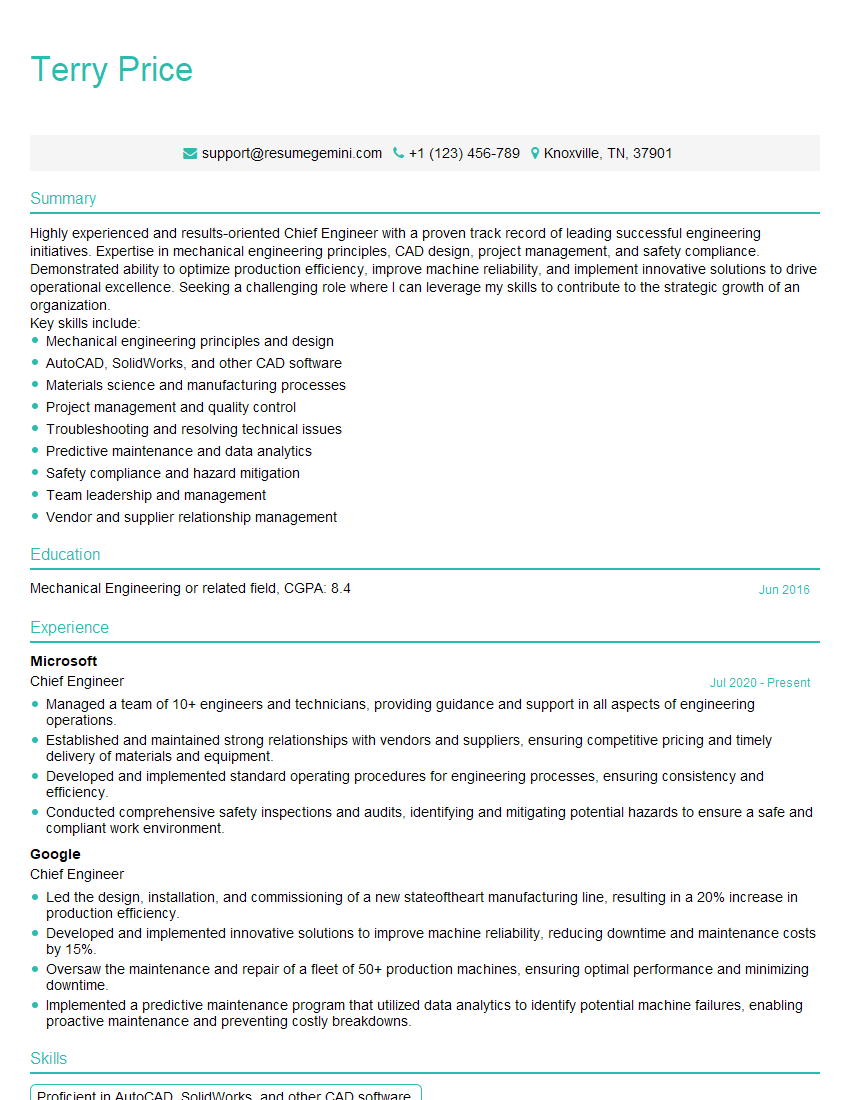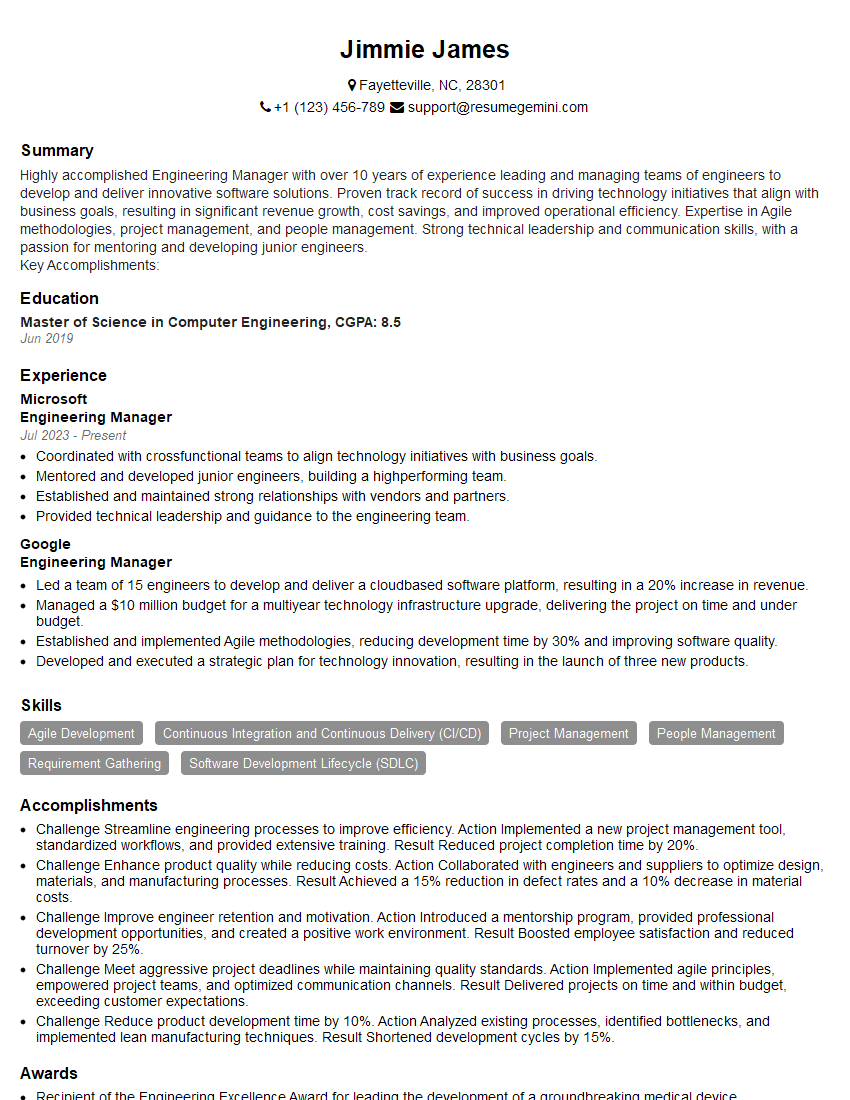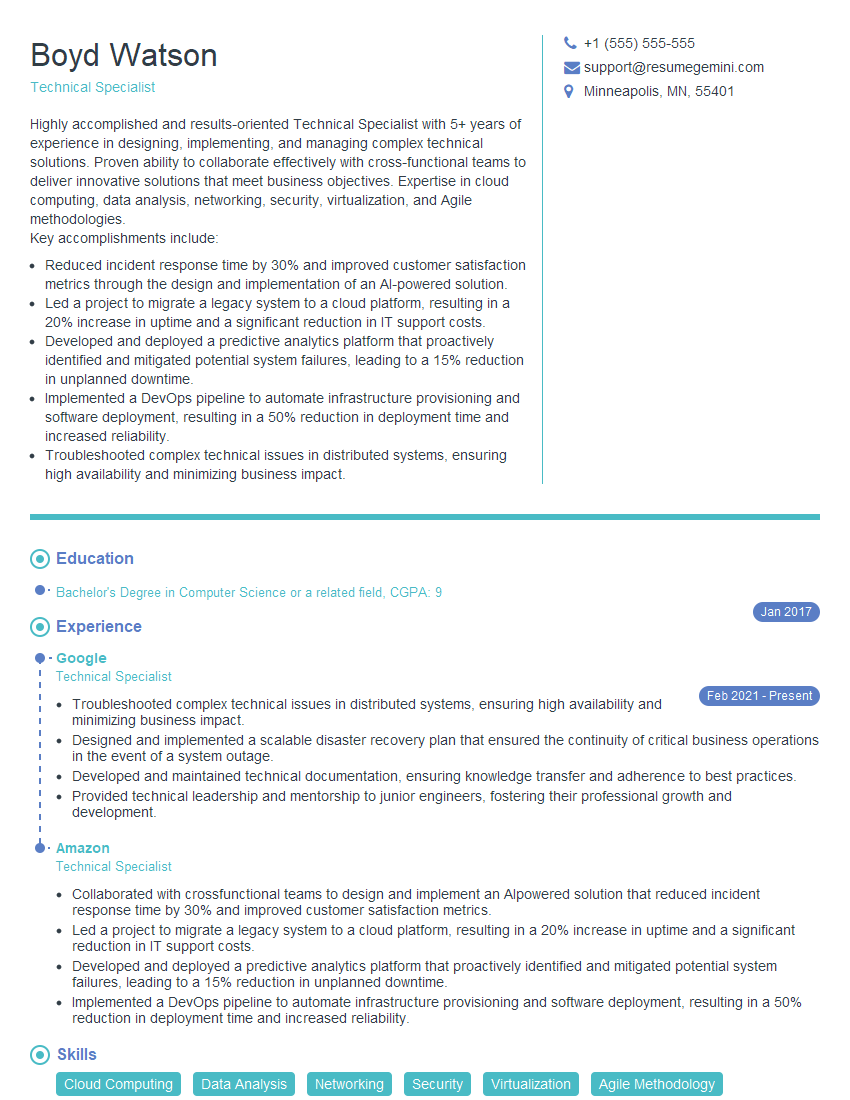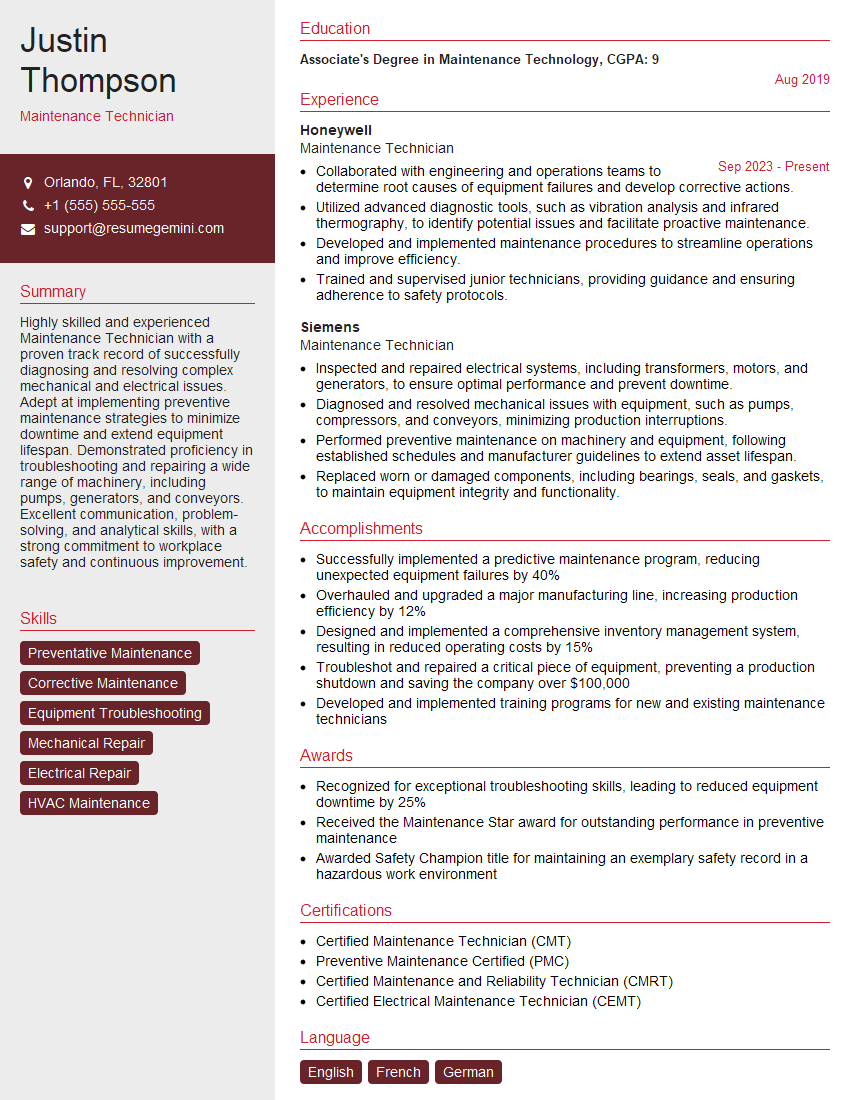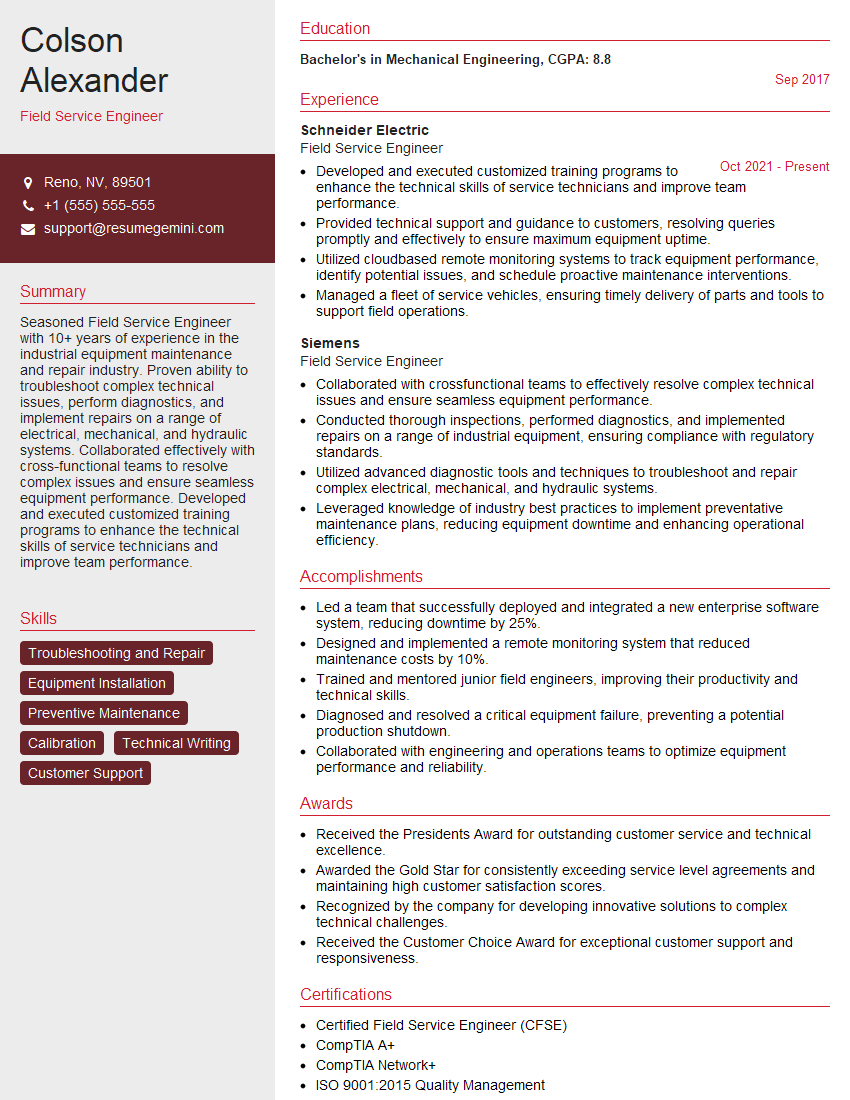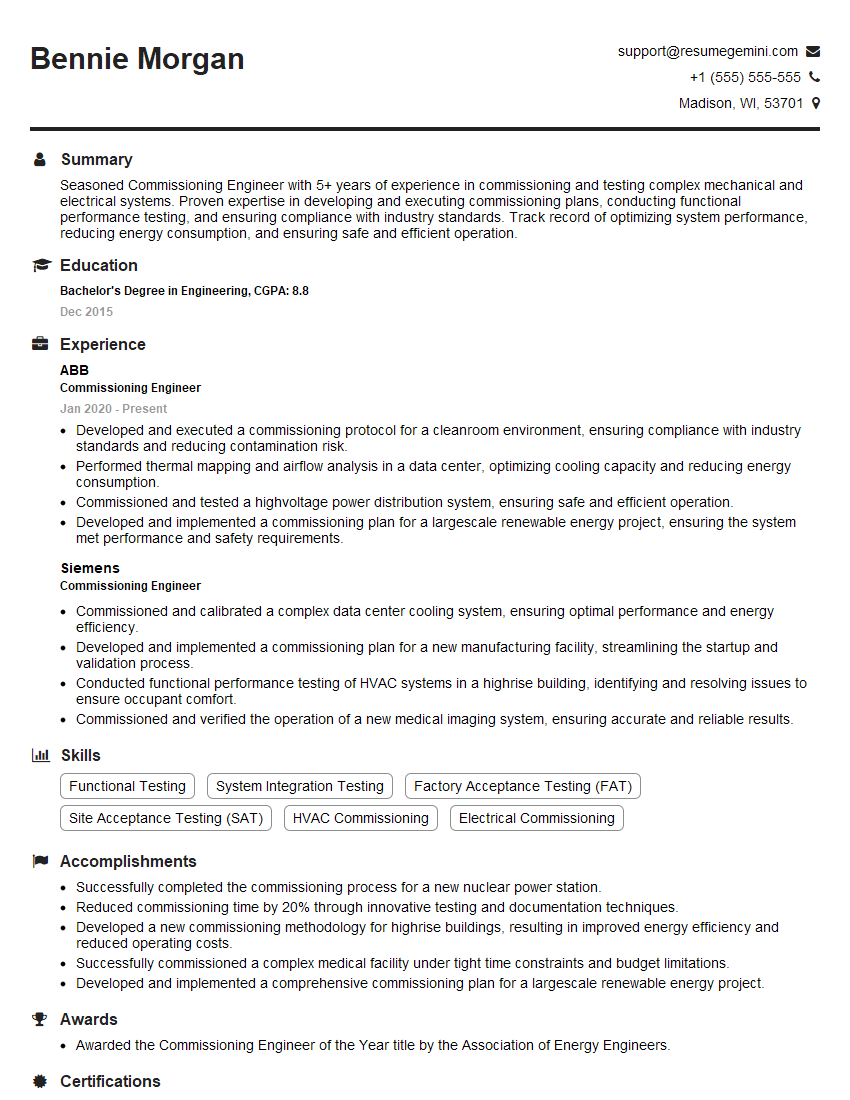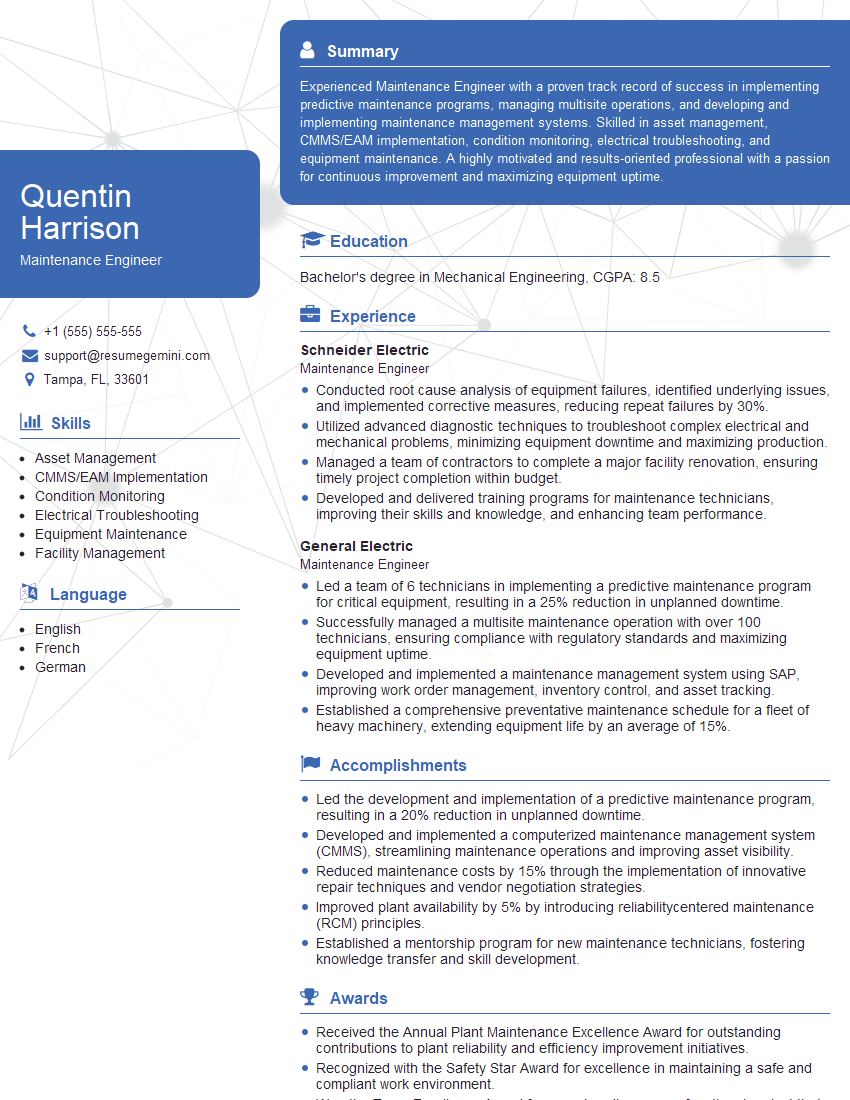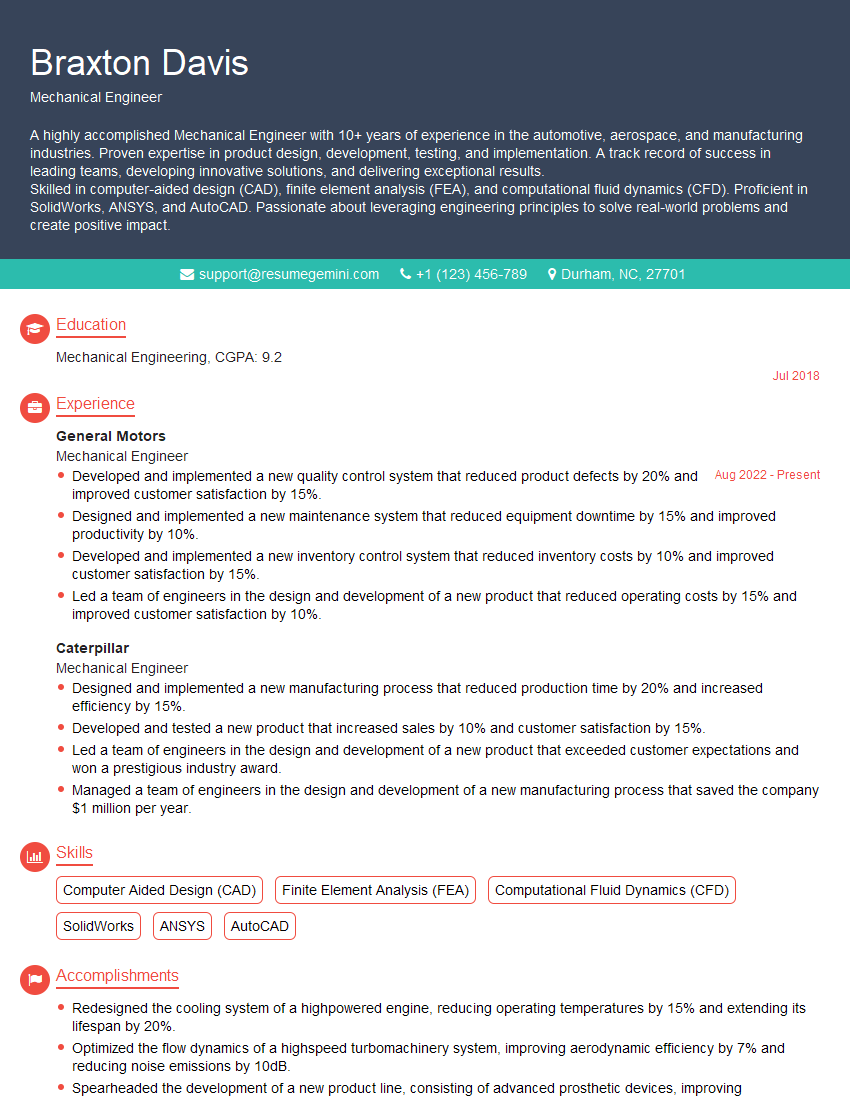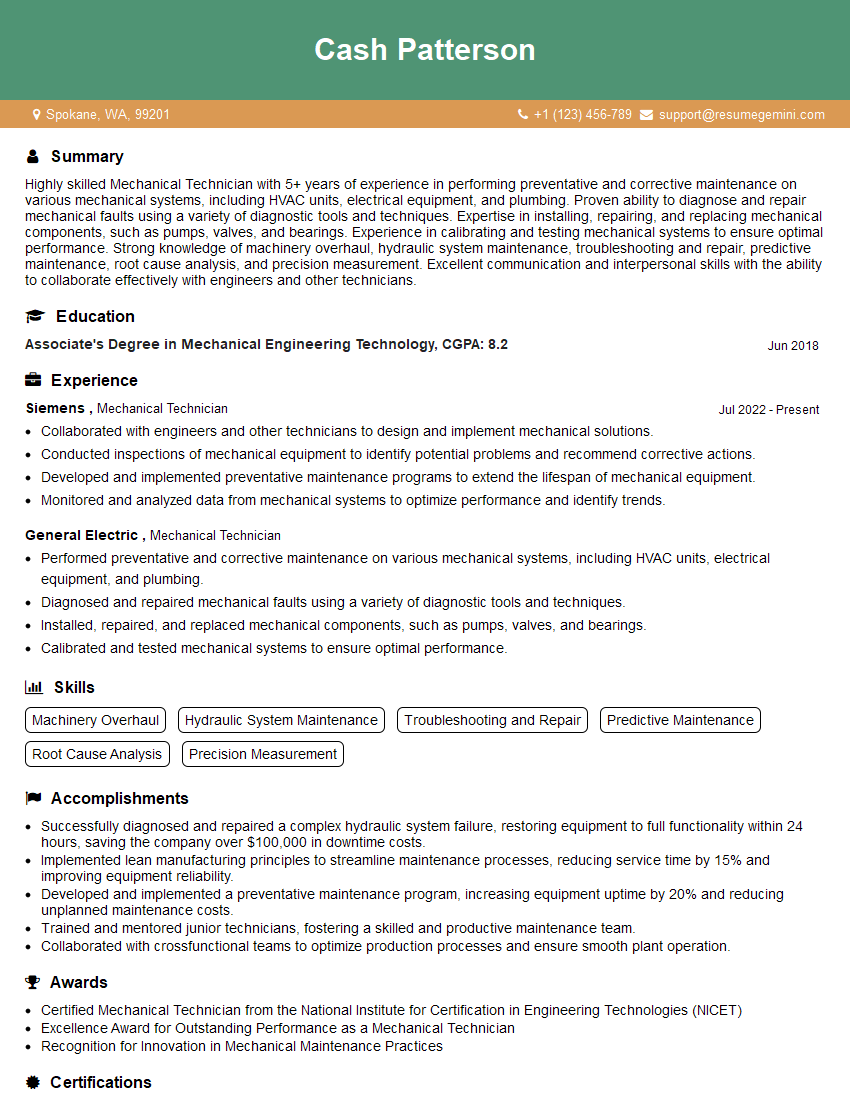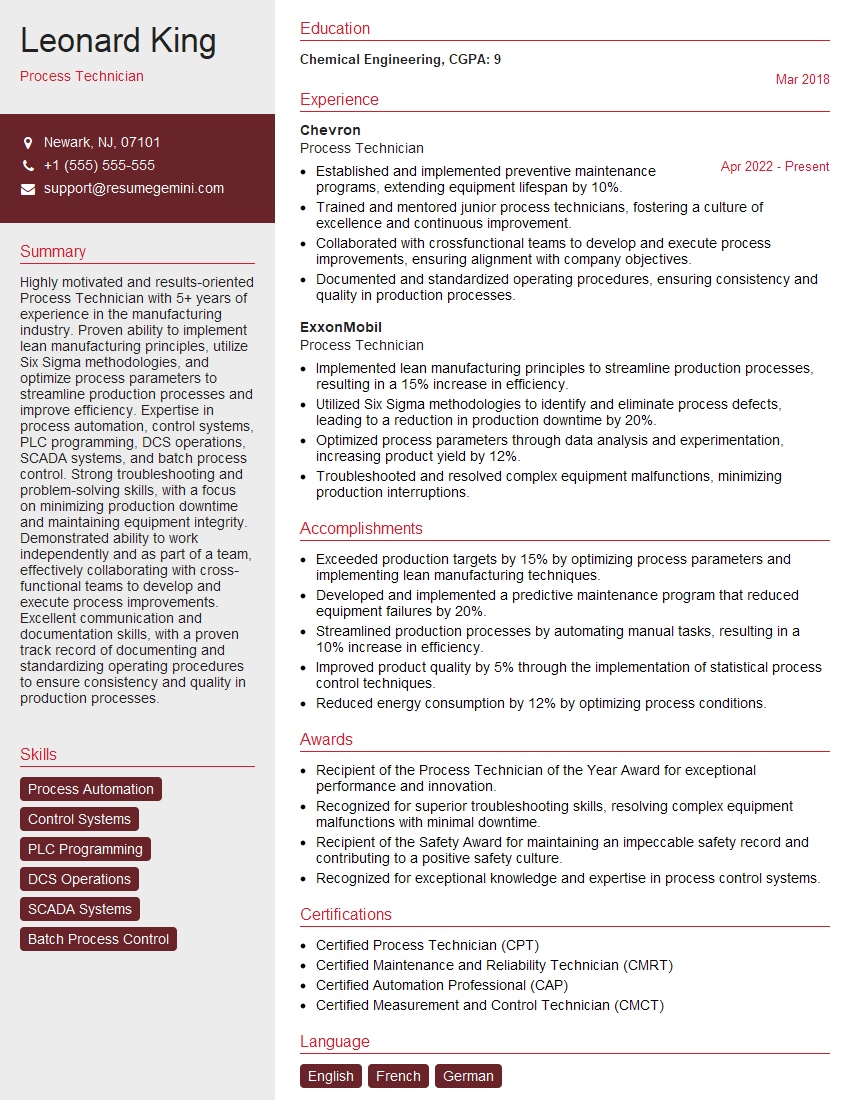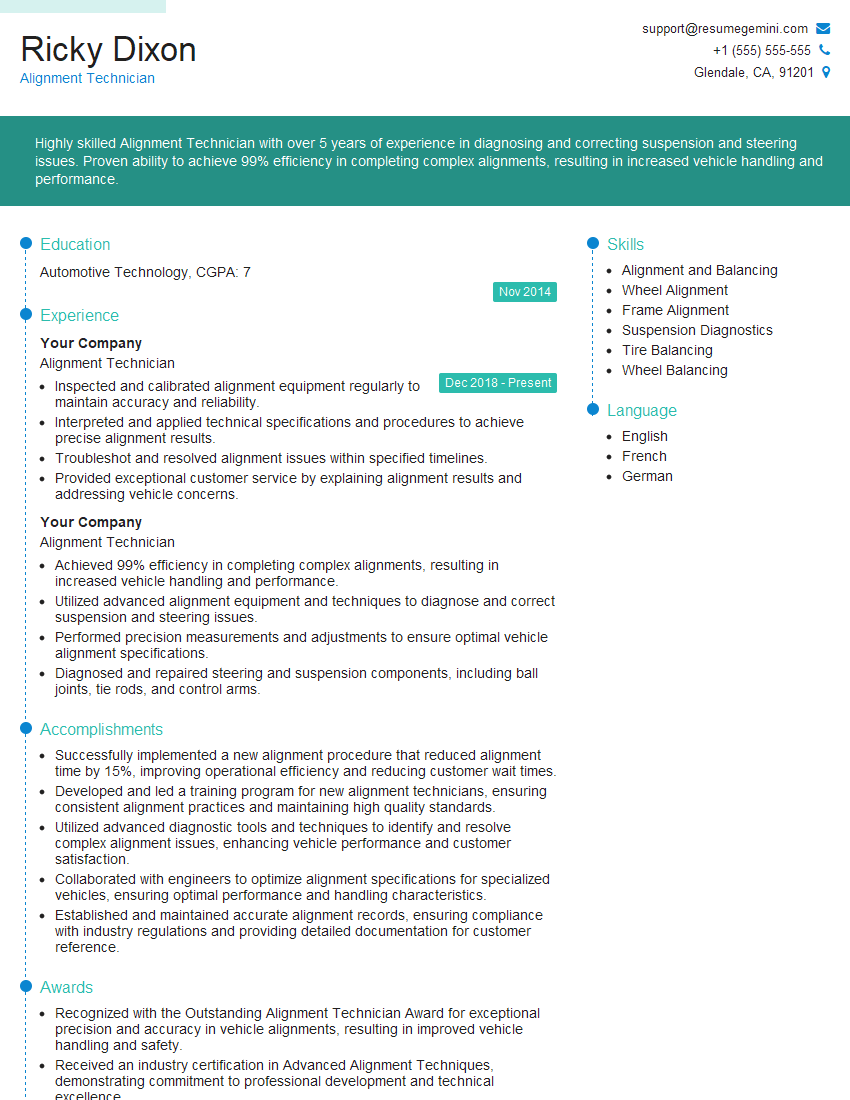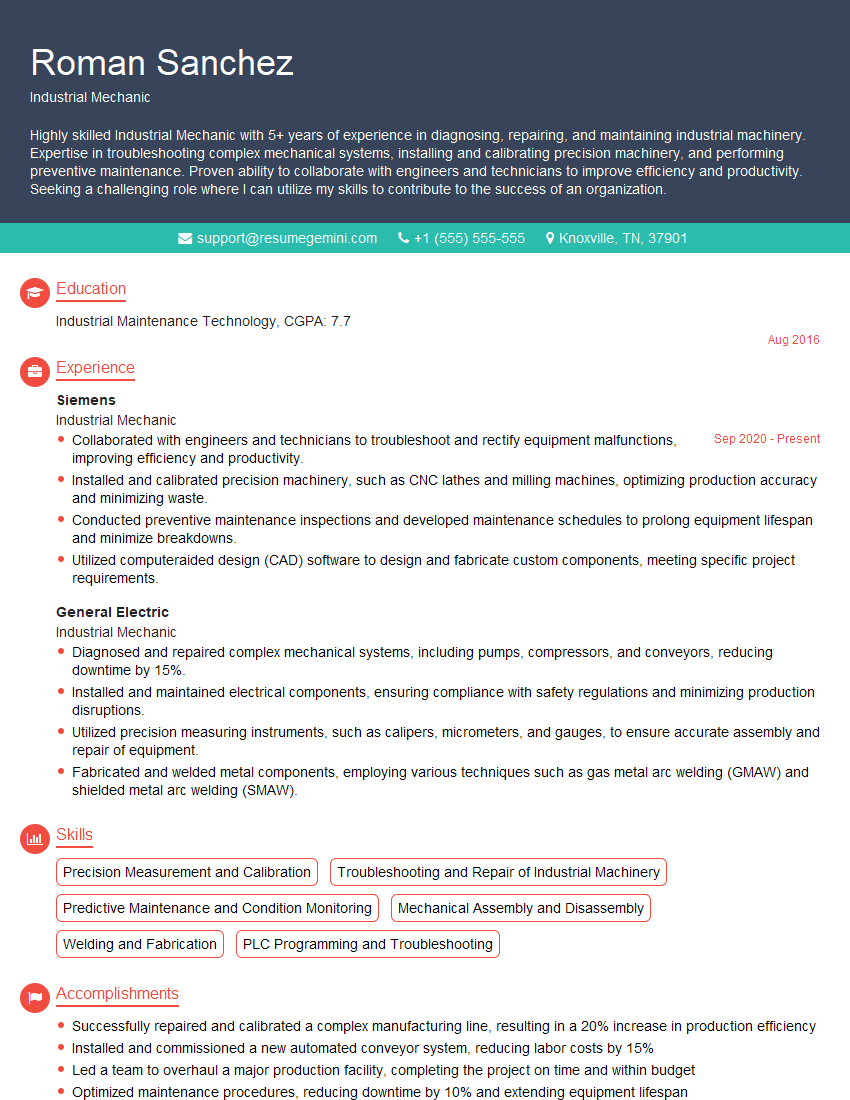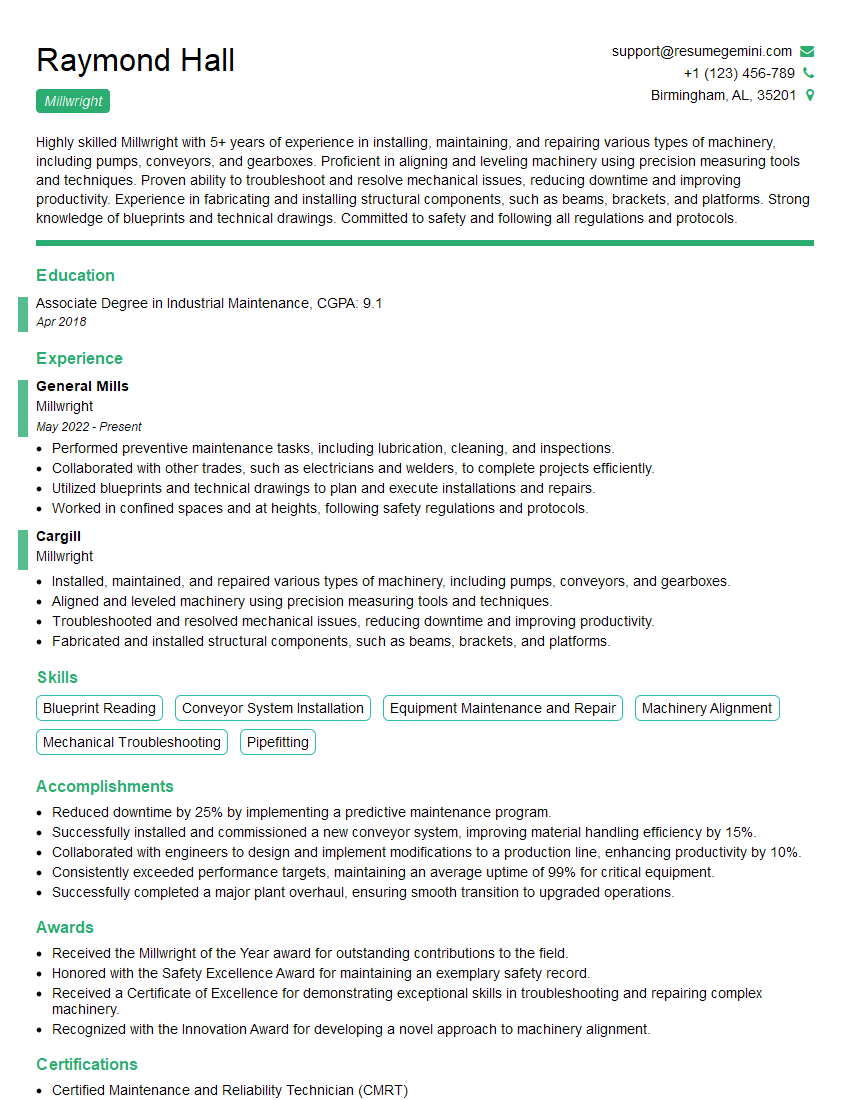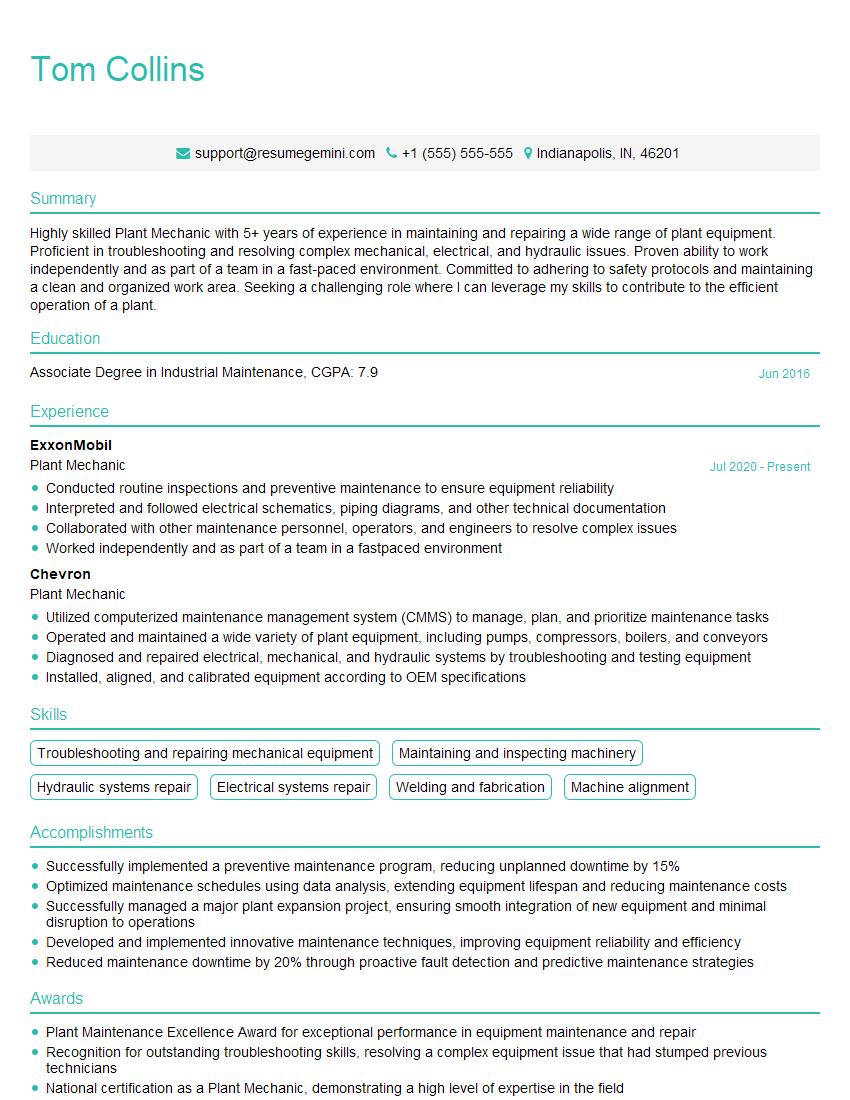The thought of an interview can be nerve-wracking, but the right preparation can make all the difference. Explore this comprehensive guide to Shaft coupling alignment interview questions and gain the confidence you need to showcase your abilities and secure the role.
Questions Asked in Shaft coupling alignment Interview
Q 1. What are the different types of shaft couplings?
Shaft couplings are mechanical devices that connect two shafts, transmitting torque and rotation while accommodating minor misalignments. The choice of coupling depends heavily on the specific application requirements. Different types offer varying levels of misalignment compensation, torsional stiffness, and operating characteristics.
- Rigid Couplings: These couplings provide a direct connection between shafts and offer high torsional stiffness. They are suitable for applications where precise alignment is maintained and there’s minimal misalignment. Examples include solid couplings and flanged couplings.
- Flexible Couplings: Designed to accommodate minor misalignments (angular, parallel, or axial). They absorb vibrations and shocks, protecting connected machinery. Common types include:
- Jaw Couplings (or Oldham Couplings): Excellent for parallel misalignment compensation. Imagine two gears meshing—that’s a simplified representation.
- Beam Couplings: Use a flexible element (often metal or elastomer) to transmit torque and absorb vibrations, accommodating angular and parallel misalignment.
- Elastomeric Couplings: These use a flexible rubber or polyurethane element to dampen vibrations and accommodate minor misalignments. They’re often found in applications needing vibration isolation.
- Universal Joints (Cardan Joints): Allow for large angular misalignment between shafts but introduce some cyclical variations in torque transmission. Think of the driveshaft in a car.
- Fluid Couplings: Use a fluid medium to transmit torque. These provide smooth acceleration, overload protection, and shock absorption.
- Magnetic Couplings: These offer non-contact torque transmission, which is useful in applications requiring isolation or preventing leakage of fluids or gases.
Q 2. Explain the principles of shaft alignment.
Shaft alignment is the process of ensuring the two shafts connected by a coupling are precisely aligned to minimize stress, vibration, and wear. Ideally, the centerlines of both shafts should be perfectly collinear. Misalignment creates forces and moments on the coupling, leading to premature failure and reduced efficiency. The principles involve minimizing three types of misalignment:
- Angular Misalignment: The shafts are at an angle to each other.
- Parallel Misalignment (Offset): The shafts are parallel but not in line.
- Axial Misalignment: The shafts are not aligned along their longitudinal axis.
Proper alignment ensures smooth torque transmission, reduces wear and tear on bearings and seals, and extends the lifespan of connected machinery. Imagine trying to push two slightly off-center gears together—that’s similar to the forces and strain that misalignment creates on shafts.
Q 3. Describe the methods used for shaft alignment (e.g., laser alignment, dial indicator).
Several methods are used to achieve precise shaft alignment. The most common are:
- Laser Alignment: This method uses laser beams to measure the misalignment between shafts. Laser alignment systems project a laser beam onto a detector at the other end of the shaft. By comparing the beam’s position with the target, even slight misalignments can be precisely quantified. Laser alignment is highly accurate and efficient, especially for long shafts or difficult-to-access machinery.
- Dial Indicator Method: A more traditional method employing dial indicators to measure the relative displacement of the shafts at various points. This requires attaching dial indicators to the shafts and measuring radial and axial runout. While accurate for many applications, it can be time-consuming and less precise than laser alignment, particularly for larger misalignments.
- Reverse Dial Indicator Method: This sophisticated technique uses dial indicators mounted on a specially designed fixture. It allows for simultaneous measurements and is particularly effective in diagnosing complex misalignment scenarios.
- Software-based alignment systems: Many modern alignment systems now incorporate software to analyze the collected data and automatically calculate the necessary adjustments.
The chosen method depends on the required accuracy, budget, and accessibility of the equipment.
Q 4. What are the common causes of misalignment?
Misalignment can stem from various factors. Some common causes include:
- Foundation Issues: Settling or unevenness of the foundation supporting the machinery.
- Thermal Expansion: Different expansion rates of shafts and machine components during operation can cause temporary misalignment.
- Wear and Tear: Wear in bearings or other machine components can lead to gradual misalignment.
- Improper Installation: Incorrect assembly or mounting of shafts and couplings.
- Manufacturing Defects: Imperfectly manufactured shafts or machine components.
- External Forces: External forces or vibrations impacting the machinery.
- Corrosion and Wear: The buildup of corrosion on shaft surfaces can cause misalignment over time.
Identifying the root cause is crucial for effective correction and preventing recurrence.
Q 5. How do you diagnose misalignment problems?
Diagnosing misalignment problems involves a combination of visual inspection and precise measurement. Here’s a typical approach:
- Visual Inspection: Check for obvious signs of misalignment, such as visible gaps between couplings, unusual noises, or excessive vibration.
- Vibration Analysis: Use vibration monitoring equipment to identify the frequency and amplitude of vibrations, helping pinpoint the source and type of misalignment.
- Alignment Measurement: Employ laser alignment or dial indicator methods to precisely quantify the extent and type of misalignment (angular, parallel, or axial).
- Temperature Measurement: Check the temperature of bearings and couplings, as excessive heating can indicate misalignment.
- Coupling Inspection: Carefully inspect the coupling for wear, damage, or deformation.
Combining these methods provides a comprehensive diagnosis for effective corrective action.
Q 6. What are the consequences of improper shaft alignment?
Improper shaft alignment has severe consequences, significantly impacting machinery performance and lifespan. The key consequences include:
- Premature Coupling Failure: Excessive stress on the coupling leads to rapid wear, damage, and ultimately, failure.
- Increased Vibration and Noise: Misalignment generates significant vibrations, leading to noise pollution and potential damage to other machine components.
- Reduced Efficiency: Misalignment reduces power transmission efficiency, wasting energy and potentially impacting productivity.
- Bearing Damage: Excessive forces on the bearings due to misalignment can lead to premature bearing failure.
- Seal Damage: Misalignment can damage seals, causing leaks and potentially environmental hazards.
- Increased Maintenance Costs: Frequent repairs and replacements due to component damage drive up maintenance costs.
- Safety Risks: In extreme cases, misalignment can lead to catastrophic equipment failure, posing safety hazards.
The costs associated with these problems far outweigh the investment in proper alignment procedures.
Q 7. Explain the importance of coupling selection based on application.
Coupling selection is critical; the wrong coupling can lead to premature failure and downtime. The choice depends on numerous factors related to the application:
- Torque Transmission Requirements: The coupling must be able to handle the operating torque and overload capacity of the connected machinery.
- Misalignment Capacity: The coupling must compensate for the expected types and magnitudes of misalignment (angular, parallel, axial).
- Operating Speed: The coupling should be designed for the intended operating speed range.
- Vibration Damping: Applications requiring vibration reduction necessitate couplings with high damping capabilities. Consider the operating environment—a high-vibration setting needs a vibration-damping coupling.
- Environmental Conditions: Factors such as temperature, humidity, and corrosive environments influence the choice of materials and coupling type.
- Maintenance Requirements: Some couplings require more frequent maintenance than others. Ease of maintenance is crucial.
- Cost Considerations: Coupling cost should be balanced against its lifespan, maintenance needs, and potential for downtime.
For example, a high-speed, high-precision application might necessitate a rigid coupling or a specialized high-precision flexible coupling, while a low-speed, high-vibration application may benefit from an elastomeric coupling. Careful consideration of all these factors ensures efficient and reliable operation.
Q 8. How do you measure and interpret alignment data?
Measuring and interpreting shaft alignment data involves using specialized tools to assess the angular and parallel misalignment between two shafts connected by a coupling. We typically use dial indicators or laser alignment systems. Dial indicators measure the relative displacement at several points around the shaft, providing readings that are then used to calculate the offset and angular misalignment. Laser alignment systems project laser beams to precisely determine the alignment, offering greater accuracy and speed. The interpretation involves comparing these measurements to manufacturer tolerances or industry best practices. For instance, a dial indicator reading might show a 0.01-inch offset and 0.02-degree angular misalignment. We then analyze if this falls within the acceptable range for the specific coupling and application.
Interpreting the data: The goal is to minimize both angular (shaft not parallel) and parallel (shaft offset) misalignment. Excessive misalignment leads to vibrations, increased wear, premature coupling failure, and potential damage to connected machinery. Interpreting the data involves comparing the measured values to the acceptable limits, usually specified in mils (thousandths of an inch) for offset and degrees or arcminutes for angular misalignment. A detailed analysis of the data may even reveal issues with the machine’s foundation or other mechanical imperfections that need correction.
Q 9. What safety precautions should be taken during shaft alignment?
Safety is paramount during shaft alignment. Before commencing any alignment work, we must always lock out and tag out the equipment, ensuring complete power isolation to prevent accidental startup. This includes disconnecting power to all motors and associated equipment. Personal protective equipment (PPE) is crucial, including safety glasses, gloves, and steel-toed shoes. We also must ensure the area around the equipment is clear of obstructions and other personnel. When using laser alignment tools, laser safety glasses are mandatory. Appropriate lifting devices and procedures should be employed when working with heavy equipment. Finally, we should always follow the manufacturer’s instructions for both the alignment tools and the equipment being aligned.
Example: Before aligning two pumps, we ensure that both the driver and the driven motor are locked out and tagged out. We will then use a laser alignment system, ensuring the operator and anyone nearby are wearing appropriate laser safety glasses. Once the alignment is complete and the equipment re-energized, we will conduct a visual inspection and test-run to ensure that all safety measures are effective and that there is no unusual vibration or noise.
Q 10. Describe the process of aligning a flexible coupling.
Aligning a flexible coupling is generally less stringent than aligning a rigid coupling because the flexible coupling can accommodate some misalignment. However, minimizing misalignment is still important to extend the coupling’s life and prevent premature wear. The process typically involves:
- Initial Inspection: Visually inspect the coupling and shafts for any obvious damage.
- Rough Alignment: Use straight edges or other tools to achieve a near-perfect alignment visually.
- Fine Alignment: Use dial indicators or a laser alignment system to precisely measure and adjust the parallel and angular misalignment.
- Coupling Installation: Carefully install the coupling following the manufacturer’s instructions.
- Verification: Verify the alignment using the alignment tool and make any necessary fine adjustments.
Note: The specific method will depend on the type of flexible coupling used (e.g., jaw coupling, elastomeric coupling). Manufacturer’s instructions should always be followed.
Q 11. Describe the process of aligning a rigid coupling.
Aligning a rigid coupling requires extreme precision because any misalignment is directly transferred to the shafts and bearings. The process usually requires:
- Preparation: Ensure both shafts are clean and free from obstructions.
- Accurate Measurement: Use a laser alignment system for accurate readings of parallel and angular misalignment. Dial indicators may be acceptable, but laser alignment provides superior accuracy.
- Adjustments: Make precise adjustments to the machine feet or base to correct any misalignment. This frequently involves shims of varying thickness placed under the machine’s feet.
- Verification: Repeatedly measure and adjust until the desired alignment tolerance is achieved.
- Bolt Tightening: Carefully tighten the coupling bolts to ensure a secure connection, following the manufacturer’s torque specifications.
Precision is key: Even slight misalignment in a rigid coupling can lead to rapid wear and failure.
Q 12. How do you handle difficult-to-access couplings?
Difficult-to-access couplings require creative solutions and specialized tools. We may need to use remote alignment systems with cameras and sensors that can measure alignment without direct access to the coupling. Magnetic bases for dial indicators can be helpful in reaching tight spaces. In some cases, we might need to temporarily remove or loosen other components to gain access. Robotics and remotely controlled alignment tools are becoming more common for such applications.
Example: If a coupling is located inside a confined space, we can use a laser alignment system with remote sensors to measure the alignment non-invasively. Then, by making adjustments to the machine’s base outside the confined space, we can accurately align the shafts.
Q 13. What are the tolerance limits for acceptable shaft alignment?
Acceptable shaft alignment tolerance limits vary depending on the type of coupling (rigid or flexible), the operating speed of the machinery, and the manufacturer’s recommendations. However, general guidelines often suggest aiming for:
- Parallel Misalignment: Less than 0.005 inches (0.127 mm) or 5 mils, although stricter tolerances might be needed for high-speed applications.
- Angular Misalignment: Less than 0.002 degrees (or 1/10 of a degree or 0.00035 radians), also varying depending on the application.
These are typical guidelines, and stricter tolerances may be necessary for high-speed or critical applications. Always consult the machinery and coupling manufacturer’s specifications for the precise tolerance requirements.
Q 14. How do you document and report alignment results?
Documentation and reporting of alignment results are essential for maintaining a record of the alignment process and ensuring future maintenance. This typically involves:
- Photographs: Before and after alignment pictures show the initial condition and final alignment.
- Alignment Readings: Record all dial indicator or laser alignment system readings.
- Calculations: Show the calculations for determining the parallel and angular misalignment.
- Shimming Information: Detail the shims used to correct alignment, their location and thickness.
- Final Alignment Report: Create a concise report summarizing the alignment process, including the date, time, equipment involved, technicians, and final alignment results.
Software provided with laser alignment systems often automates a significant portion of this documentation. The information should be stored safely and easily accessible for future reference.
Q 15. What software or tools do you use for shaft alignment?
Shaft alignment relies heavily on specialized tools and software. The most basic tools include dial indicators, precision levels, and alignment bars. However, modern practices often incorporate laser alignment systems which provide significantly more accurate and efficient measurements. These laser systems can be standalone units or integrated into sophisticated software packages.
The software I most frequently use allows for real-time data acquisition, analysis, and reporting. This includes features like automated calculations of offset and angular misalignment, graphical representations of the shaft alignment status (often in 3D), and the generation of detailed reports which are crucial for record-keeping and troubleshooting. Some popular software packages I’ve used are Alignement Pro, Easy-Laser XT, and Lufft. Each offers slightly different features and functionalities but generally achieve the same goal: precise measurement and analysis of shaft alignment.
Beyond the software and sophisticated laser systems, I also rely on traditional methods for verification and validation in certain situations, like using dial indicators to double-check specific measurements. It’s important to have a well-rounded skillset.
Career Expert Tips:
- Ace those interviews! Prepare effectively by reviewing the Top 50 Most Common Interview Questions on ResumeGemini.
- Navigate your job search with confidence! Explore a wide range of Career Tips on ResumeGemini. Learn about common challenges and recommendations to overcome them.
- Craft the perfect resume! Master the Art of Resume Writing with ResumeGemini’s guide. Showcase your unique qualifications and achievements effectively.
- Don’t miss out on holiday savings! Build your dream resume with ResumeGemini’s ATS optimized templates.
Q 16. How do you troubleshoot common alignment problems?
Troubleshooting alignment problems starts with a systematic approach. First, I carefully review the alignment report generated by the laser system. This helps pinpoint the type and magnitude of misalignment – whether it’s primarily angular (one shaft is tilted relative to the other) or parallel (one shaft is offset from the other). I also consider the coupling type, as different couplings have different tolerances for misalignment.
Common problems include soft foot (uneven support of a machine’s base), foundation issues (settling or vibration), and inadequate coupling selection. If the problem is persistent, I look for signs of wear on the coupling or bearings – which might indicate a different root cause that affects alignment. I’ll also check the machine’s operational history to determine if changes have been made, like new equipment or piping, that could have introduced stress. Sometimes, simply re-checking the alignment after resolving another issue can improve the alignment. It’s iterative process. If I cannot isolate the problem by this visual inspection and data analysis, I will investigate using additional vibration analysis techniques.
Q 17. What are the advantages and disadvantages of different alignment methods?
Several alignment methods exist, each with its own advantages and disadvantages:
- Traditional Dial Indicator Method: This method is relatively inexpensive and requires minimal specialized equipment but is time-consuming, labor-intensive, and prone to human error leading to less accurate results.
- Laser Alignment Systems: These systems are much faster, more accurate, and provide a comprehensive report. However, they represent a significant investment and require training to use effectively. They are less susceptible to human error.
- Reverse Dial Indicator Method: This method uses dial indicators in combination with shims or similar, to minimize the amount of realignment needed. This is more efficient and results in reduced downtime.
The choice of method depends on factors such as budget, available resources, required accuracy, and the size and complexity of the equipment. For critical applications demanding high precision, laser alignment is usually preferred; while for less critical systems, the traditional dial indicator method might suffice.
Q 18. How does temperature affect shaft alignment?
Temperature significantly impacts shaft alignment. Materials expand and contract with changes in temperature; this is especially true for longer shafts. A machine operating at a significantly different temperature than when it was aligned will experience misalignment. For example, a pump operating at high temperatures might experience thermal growth that leads to misalignment, causing increased vibration and wear on components.
To account for this, it is crucial to align equipment at its normal operating temperature whenever possible, or to accurately compensate for temperature changes using the thermal expansion properties of the shaft material. Some advanced alignment systems are able to compensate for this using algorithms or through temperature inputs. This type of compensation is crucial for ensuring long-term alignment stability. For large shafts or high temperature variations, I might specify special materials or alignment methods to improve stability.
Q 19. How often should shaft alignment be checked?
The frequency of shaft alignment checks depends on several factors, including the criticality of the equipment, the operating environment (vibration, temperature variations), the type of coupling used, and the machine’s historical performance.
A well-maintained system in a stable environment with a robust coupling may only require alignment checks annually or even less frequently. In contrast, a machine subjected to significant vibration, temperature fluctuations, or frequent starts and stops might need checks every few months or even more often. Many plants utilize a preventative maintenance schedule, often tied to vibration monitoring and operational data. Early warning systems are crucial here.
In critical applications, predictive maintenance technologies utilizing vibration analysis help determine the need for immediate alignment checks and avoiding unplanned downtime.
Q 20. Explain the concept of soft foot.
Soft foot is a common alignment problem that occurs when one or more feet of a machine’s base are not in complete contact with the foundation. This uneven support causes the machine’s base to twist, introducing significant misalignment between the shafts of the coupled equipment. Imagine trying to align two perfectly straight pencils on an uneven surface; one end will be higher or lower, introducing angular misalignment.
This twisting creates stresses within the machine, causing excessive vibration and premature wear of bearings and couplings. The soft foot is not immediately obvious as it is an uneven contact rather than an obvious displacement.
Q 21. How do you correct soft foot?
Correcting soft foot involves ensuring all feet of the machine are in full and even contact with the foundation. This is usually accomplished by using shims.
The procedure I typically follow is:
- Measure the foot-to-foundation gap at each foot of the machine base using feeler gauges or other precise measuring tools.
- Identify the highest foot (or feet). This is the point of minimal contact.
- Shim under the lowest feet until the gap measurements are approximately equal at all feet, thus improving contact with the base.
- Re-check the alignment after shimming. There will often be an improvement to shaft alignment after correcting soft foot.
- Re-torque the machine feet.
Careful shimming is essential; too much shimming can introduce additional problems. A few small shims are often preferred to one large shim.
Q 22. What is the role of shims in shaft alignment?
Shims are thin pieces of metal, typically steel, used in shaft alignment to make minute adjustments to the position of a machine’s base or feet. Think of them as precision wedges. They’re essential because achieving perfect alignment often requires adjustments smaller than what can be practically achieved by simply moving large equipment.
In practice, shims are placed between the machine’s feet and the foundation to correct for any misalignment detected during the alignment process. By adding or removing shims, we can finely tune the horizontal and vertical positions of the shafts, bringing them into proper alignment.
For instance, if a laser alignment shows a slight vertical offset, we’d add shims under one side of the machine’s base to raise it, bringing the shafts closer to perfect alignment. The thickness of the shims is precisely measured to ensure accuracy.
Q 23. How do you use a laser alignment system?
Laser alignment systems use a laser beam to precisely measure the angular and parallel misalignment between two shafts. It’s a highly accurate and efficient method, especially for larger machines where dial indicators might be cumbersome.
The process typically involves mounting laser transmitters and receivers on the shafts of the coupled machines. The laser beams are then projected from one shaft to the other. The system measures the deviation of the beam from its ideal path, providing precise readings of both angular and offset misalignment in both vertical and horizontal planes.
The system’s software then calculates the necessary adjustments to correct the misalignment. This usually involves making adjustments to the machine’s feet using shims or other means. The beauty of laser alignment is the immediate feedback and precise measurements it offers, leading to much faster and more precise alignment compared to traditional methods.
Q 24. How do you use a dial indicator for shaft alignment?
Dial indicator alignment, a more traditional method, uses a dial indicator mounted on a magnetic base to measure the relative positions of the shafts. This method requires more manual skill and is more time-consuming, especially for significant misalignments.
The process usually involves mounting the dial indicator on one shaft and carefully rotating the other shaft. The dial indicator’s needle shows the deviation from perfect alignment. Readings are taken at multiple points along the shaft circumference (usually 12 or more points) to obtain a complete picture of the misalignment.
These readings are then used to calculate the necessary adjustments. While less precise than laser alignment for large offsets, dial indicator alignment remains a valuable tool, especially for smaller machines or when a laser system isn’t readily available. It’s crucial to ensure the indicator is properly mounted and zeroed for accurate measurements.
For example, we’d use the dial indicator’s readings to calculate the required shim adjustments at each machine foot to bring the shaft to proper alignment. Careful measurements at different radial positions are crucial to identify both parallel and angular misalignments.
Q 25. Describe your experience with different types of couplings (e.g., jaw, flexible, gear).
My experience spans various coupling types. Jaw couplings are simple and robust, suitable for applications with moderate misalignment tolerance. I’ve used them extensively in less demanding industrial settings. They are relatively inexpensive and easy to maintain.
Flexible couplings, like elastomeric couplings, offer greater misalignment compensation and vibration damping. These are preferred in applications where precise alignment is difficult to maintain or where vibration is a significant concern. I’ve worked with these on high-speed machinery and applications needing vibration reduction.
Gear couplings provide high torque capacity and are suitable for high-precision applications. Their intricate design requires more careful alignment and maintenance compared to jaw or elastomeric couplings. I’ve utilized them in heavy machinery where high torque transmission and precise alignment are paramount.
The choice of coupling depends heavily on the specific application’s needs, considering factors like torque requirements, misalignment tolerance, operating speed, vibration characteristics, and cost.
Q 26. How do you ensure the accuracy of your alignment measurements?
Ensuring accuracy is paramount. For laser alignment, this involves verifying the laser system’s calibration, ensuring proper mounting of the transducers, and confirming the readings with multiple measurements. This also includes validating the environmental conditions—temperature fluctuations, for example, can affect readings.
With dial indicator methods, accuracy depends on the proper mounting and zeroing of the indicator, careful reading and recording of measurements, and using multiple readings along the shaft’s circumference to account for potential variations. Proper tool maintenance and operator skill are also crucial factors.
Beyond the measurement process itself, I always double-check my calculations and compare them to the initial readings to verify the corrections are sensible and appropriately address the identified misalignment issues. In essence, a multi-faceted approach focused on systematic calibration, careful measurement, and verification of results is critical to obtaining accurate alignment.
Q 27. Explain the difference between static and dynamic alignment.
Static alignment focuses on correcting misalignment when the machinery is at rest. It aims to ensure the shafts are properly aligned before the machine is started. We typically use laser or dial indicator methods for static alignment.
Dynamic alignment, on the other hand, considers the effects of the machinery’s operation on the alignment. It’s typically performed while the machine is running at operational speed and considers factors such as vibration and centrifugal forces, which can affect the shaft alignment under load. Specialized sensors and analysis techniques are employed in dynamic alignment.
While static alignment is a crucial first step, dynamic alignment ensures optimal performance and reduces stress and wear on the components, especially crucial in high-speed or high-torque applications. Sometimes, a slight adjustment is needed after static alignment once the machine is running at operational speeds.
Q 28. Describe a time you had to troubleshoot a complex alignment issue.
I once encountered a complex alignment issue on a large industrial pump. Initial static alignment using a laser system seemed successful, but during operation, the pump exhibited excessive vibration and high bearing temperatures, indicating a persisting alignment problem.
We investigated further using both dynamic alignment techniques and thorough vibration analysis. We discovered that the foundation itself had subtle unevenness, causing a slight shift in alignment under load, despite the initial static alignment seeming correct. The foundation was reinforced, and we performed a new static alignment, addressing the foundation-induced problem. After these corrective measures, the pump operated smoothly without the previous issues.
This experience highlighted the importance of considering all possible factors, including the condition of the machine foundation and the potential influence of operational loads, when troubleshooting complex alignment problems. A comprehensive approach, involving various alignment techniques and vibration analysis, was crucial to resolving the issue successfully.
Key Topics to Learn for Shaft Coupling Alignment Interview
- Types of Shaft Couplings: Understanding the characteristics and applications of different coupling types (rigid, flexible, fluid, etc.) is crucial. Consider their strengths and weaknesses in various operating conditions.
- Alignment Methods: Mastering various alignment techniques, including dial indicator methods, laser alignment systems, and their respective advantages and limitations. Be prepared to discuss the precision requirements for each method.
- Misalignment Effects: Thoroughly understand the consequences of improper shaft alignment, such as vibration, premature wear, increased power loss, and potential equipment damage. Be able to explain how these effects impact operational efficiency and maintenance costs.
- Troubleshooting and Diagnostics: Develop your ability to identify and diagnose misalignment issues based on observed symptoms (vibration patterns, noise levels, temperature variations). This includes understanding the use of vibration analysis tools and interpreting their data.
- Safety Procedures: Demonstrate your knowledge of safety protocols and best practices related to shaft coupling alignment, including lockout/tagout procedures and personal protective equipment (PPE) requirements.
- Alignment Tolerances and Specifications: Learn to interpret engineering drawings and specifications related to shaft alignment tolerances. Understand how these tolerances impact the overall performance and longevity of the coupled system.
- Maintenance and Inspection: Discuss routine maintenance tasks associated with shaft couplings and the importance of regular inspection to prevent misalignment and ensure optimal performance.
Next Steps
Mastering shaft coupling alignment is essential for career advancement in many engineering and maintenance roles. A strong understanding of these principles demonstrates a commitment to operational efficiency, safety, and cost reduction. To increase your job prospects, focus on crafting a compelling and ATS-friendly resume that showcases your skills and experience effectively. ResumeGemini can significantly enhance your resume-building experience. They offer tools and resources to create a professional resume, and provide examples of resumes tailored to Shaft Coupling Alignment roles, helping you stand out from the competition.
Explore more articles
Users Rating of Our Blogs
Share Your Experience
We value your feedback! Please rate our content and share your thoughts (optional).
What Readers Say About Our Blog
Hello,
We found issues with your domain’s email setup that may be sending your messages to spam or blocking them completely. InboxShield Mini shows you how to fix it in minutes — no tech skills required.
Scan your domain now for details: https://inboxshield-mini.com/
— Adam @ InboxShield Mini
Reply STOP to unsubscribe
Hi, are you owner of interviewgemini.com? What if I told you I could help you find extra time in your schedule, reconnect with leads you didn’t even realize you missed, and bring in more “I want to work with you” conversations, without increasing your ad spend or hiring a full-time employee?
All with a flexible, budget-friendly service that could easily pay for itself. Sounds good?
Would it be nice to jump on a quick 10-minute call so I can show you exactly how we make this work?
Best,
Hapei
Marketing Director
Hey, I know you’re the owner of interviewgemini.com. I’ll be quick.
Fundraising for your business is tough and time-consuming. We make it easier by guaranteeing two private investor meetings each month, for six months. No demos, no pitch events – just direct introductions to active investors matched to your startup.
If youR17;re raising, this could help you build real momentum. Want me to send more info?
Hi, I represent an SEO company that specialises in getting you AI citations and higher rankings on Google. I’d like to offer you a 100% free SEO audit for your website. Would you be interested?
Hi, I represent an SEO company that specialises in getting you AI citations and higher rankings on Google. I’d like to offer you a 100% free SEO audit for your website. Would you be interested?
good
